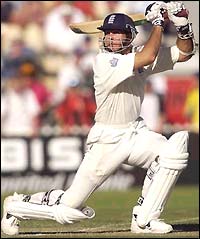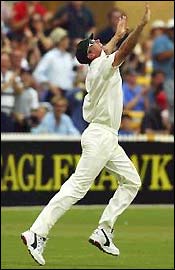Ashes popular despite the cricket
Daniel Laidlaw
It can be difficult to distinguish the reality from the hype in an Ashes
series. Promoters, players and some media would have us believe an Ashes
series is still the ultimate, the pinnacle of cricket, at least for the two
teams concerned. Unfortunately, these aren't reliable sources, as it
partially serves their interests for the series to continue to be perceived
that way.
Nothing will ever detract from the history of the Ashes, but history alone
doesn't keep its premiere status intact. The standing of any series is
mostly determined by the form and fortunes of the combatants, which
presently don't elevate the Ashes to particularly lofty heights. The same
comments tend to be recycled each series, but they carry increasingly less
meaning.
Nevertheless, the Ashes will and should remain a pre-eminent series as long
as it continues to be well-supported by the public, which it definitely is.
It's sometimes easy to forget that outside of Australia, England, India and
the West Indies, people mostly don't give a damn about Test cricket, or at
least aren't enthralled to such an extent as to attend matches in any great
numbers. It would not make economic or sporting sense, therefore, to reduce
one of the few remaining series that many do in fact support and want to
see. Test cricket is not so strong as to be able to afford to sacrifice some
of the support that keeps its culture alive.
A significant part of the support for the current series derives from the
admirably committed English tourists. The first Test in Brisbane had an
attendance of 81,277, the highest since Bodyline, which was seen as evidence
of the series' enduring popularity among Australians, and Adelaide drew a
healthy 20,000-plus across the first three days. However, it would not be
surprising to learn that 5 to 8,000 of the spectators in attendance on each of
those days were England supporters. You could hardly move around without
being surrounded by various England shirts and hearing English accents. In
the public tier of the Bradman stand, Australians were in a minority, and it
did not appear too different in the Sir Edwin Smith. This excludes the Barmy
Army on the hill. The level of support was remarkable.
 Those travelling supporters had reason to be optimistic on day one, but as
ever their caution was justified. How does a team go from 295/3 in the last
over of the first day to losing by an innings inside four days? The answer
is a long tail, weakened attack and opponents to exploit both to fullest
advantage.
Those travelling supporters had reason to be optimistic on day one, but as
ever their caution was justified. How does a team go from 295/3 in the last
over of the first day to losing by an innings inside four days? The answer
is a long tail, weakened attack and opponents to exploit both to fullest
advantage.
Despite being on the losing side, Michael Vaughan would arguably have been a
more deserving man-of-the-match than Ricky Ponting, considering the
respective quality of bowling they faced. Vaughan has the shots and, just as
importantly, the attitude. Thanks largely to him, England outplayed
Australia on a controversial day one.
It was Vaughan's non-dismissal on 19 rather than the magnificence of his
innings, however, that drew prolonged comment. More people are gradually
awakening to the inadequacies of using TV pictures to determine catches, as
the third umpire system continues to harm cricket. Palpably caught in the
gully by Langer off Bichel, Vaughan refused to walk and was mysteriously
reprieved. Evidently feeling 1-0 down in the poor decision stakes, Bichel
then claimed a return catch off Trescothick that clearly bounced, and Key
held his ground when caught by Ponting at silly point. The players are
mostly to blame for this lack of trust, but they aren't helped by a system
which allows them to profit from it.
The first session of day two irrevocably changed the course of the match, as
England lost their last seven wickets for 47, including the last six in that
session. Putting behind them the four dropped catches on the first day,
Gillespie, Warne and McGrath created and sustained pressure in a superb
display, highlighting one the differences between the sides on a good pitch.
Whereas Australia could afford to drop difficult catches in the knowledge
their bowlers would create more, England were under pressure to maximise
every half-chance, knowing opportunities provided would be scarce.
England studied tapes of Hayden and the result was to install a short mid-wicket and short mid-off, with the apparent intention to bowl straight and
cut off his airborne drives. Despite the tactic, the openers peeled off 80
in their first hour together against an ineffective Caddick and Hoggard, on
the way to another 100-run partnership.
It eventually worked, though, as Hayden sliced a catch to mid off,
unnecessarily attempting a glory shot over the top to reach his fifty. White
captured four wickets, including that one, but Harmison appeared most
threatening. The huge 6"8 speedster harried the batsmen when others hadn't,
generating awkward bounce that caused mistimed shots. With he and Jones
together, England might have had an attack with some potential. As it was,
their resources were thin -- with Ponting and Martyn consolidating, Hussain
eschewed the aggressive pursuit of wickets in favour of containment, with a
deep cover, third man and backward-square all allowing singles, which
Ponting and Martyn sensibly accumulated.
Even after Martyn was dismissed, this tactic contentiously returned --
Ponting was deliberately 'walked' in order to get the once-feared Steve
Waugh on strike. Hussain may have had the last laugh in this battle, but he
dropped Waugh at leg gully on two. We haven't seen the last of this line of
attack.
Australia declared their innings early after Bichel's tail-end
entertainment, as well they might have with rain forecast -- England came
closer to drawing the second Test than they probably realised. There would
have been little, if any, play on day five, so had more wickets been
preserved on the third evening and greater resolve shown in the drizzle on
day four, the match could well have been saved.
 Australia's victory push was hastened by one of the great outfield catches
by Glenn McGrath. In what will undoubtedly be a fondly-recalled career
highlight, the paceman sprinted from deep backward-square and dived full
length to freakishly hold a skied Vaughan sweep leading up to lunch.
Ecstatic and engulfed by team-mates, the effort drew a second round of
amazed appreciation when replayed on the big screen.
Australia's victory push was hastened by one of the great outfield catches
by Glenn McGrath. In what will undoubtedly be a fondly-recalled career
highlight, the paceman sprinted from deep backward-square and dived full
length to freakishly hold a skied Vaughan sweep leading up to lunch.
Ecstatic and engulfed by team-mates, the effort drew a second round of
amazed appreciation when replayed on the big screen.
Though Australia wrapped up the match before the rain set in to take a
stranglehold on the series, the Barmy Army were among the few Englishmen not
to concede the Ashes for another two years: "We're going to win 3-2, we're
going to win 3-2... ."
Second Test - Day 4 report
Slide show - Images from day 4
More Columns
Mail Daniel Laidlaw